Scanning Around With Gene: Made-Up Names for Made-Up Products
Today’s pharmaceutical companies seem to come up with a lot of good product names. It’s not easy to create a name that is unique and available as a trademark and URL, so the pressure is great. But as long as industry has been making up products, it’s been making up names to describe them.
The heyday of product naming corresponds to the “chemical revolution” of the 1940s and ’50s, when the big chemical and rubber companies were cranking out products on a regular basis. And like the drugs of today, the manufacturers sold these products to consumers as readily as to the industries the products served. Click on any image for a larger view.


We all know the danger that comes if your promotion of a new brand is too successful: The name becomes a generic descriptor for a range of products, not just yours. But it’s hard to know exactly why one name takes off and another doesn’t. Here, for example, are several more ads for the new DuPont and Sylvania product called Cellophane, which certainly ended up in the generic-name category.
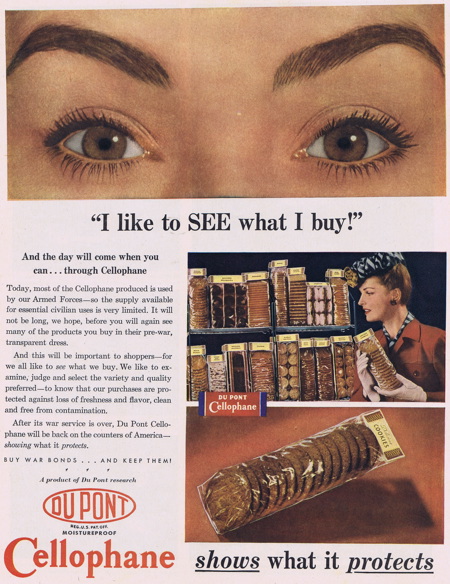

But why didn’t the name of Goodyear’s competing product, Pliofilm, catch the public’s attention? Or Viscose from the American Viscose Corporation? Or even Transveneer? Was it the name or the size of the advertising budget? Pliofilm doesn’t exactly roll off the tongue like Cellophane. But I do remember as a child that my dad would refer to any clear plastic as “visqueen,” which Wikipedia tells me is indeed a brand name, albeit one that has since lost popularity as a general term.



Most of these brand names have something to do with the chemical components or materials used in construction, such as Fiberglass (Fibers of Glass) or Acrilan (Acrylic). And while you may think Bakelite is named after some sort of “baking” process, it’s actually for the Belgian chemist Dr. Leo Baekeland who invented it.




Firestone Foamex and U.S. Koylon Foam seem pretty self-explanatory. At least we know they’re some sort of foamy product, though up until these brands came out, foam was something most people associated with an ice-cream soda, not a car seat.


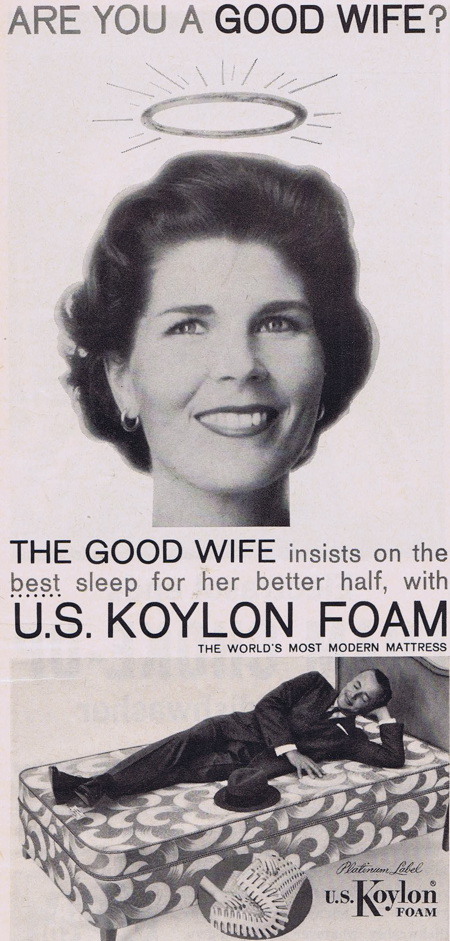
I’m not exactly sure what Firestone Velon is, but since it’s used in rainwear and seat covers, I have to believe it’s impermeable. So I sure hope the small child in the last ad didn’t get too wrapped up in those Velon curtains.

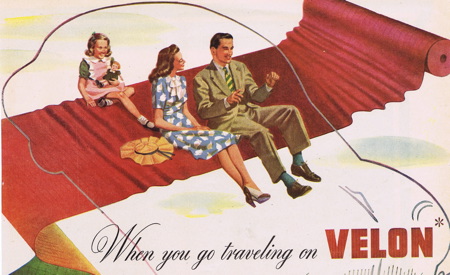

Plastic-inspired fabric seems to have been quite the thing back then, with several competitors to Firestone’s Velon. There was Goodyear’s Koroseal, Krene Plastic Products, and Eastman Chromspun, an acetate fabric.

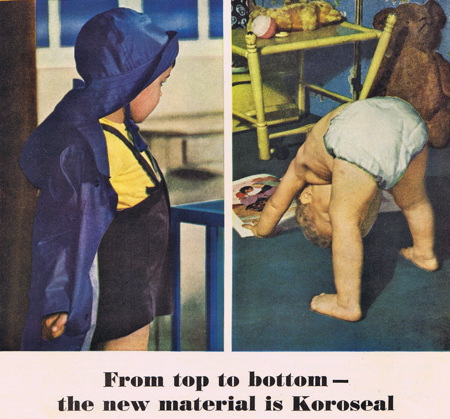


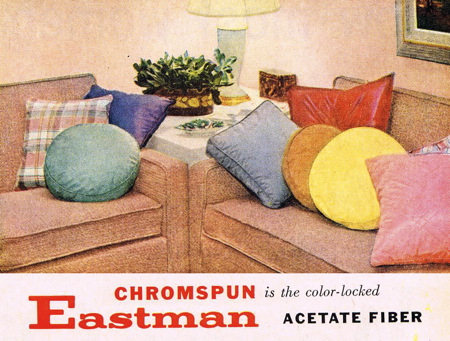
In fact, invented-fabric naming reached a frenzy during the 1950s and ’60s. There was Nylon, Tricot, Rayon, Durene, and Naugahyde, just to name a few.
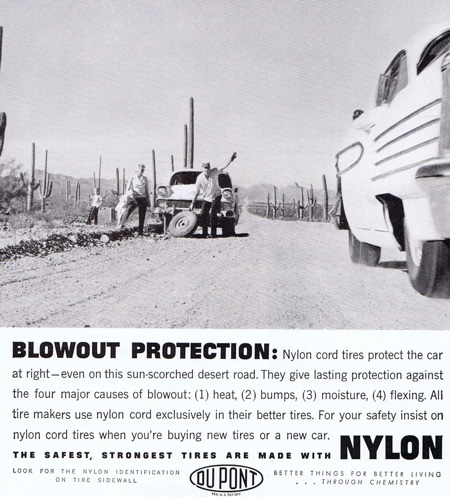

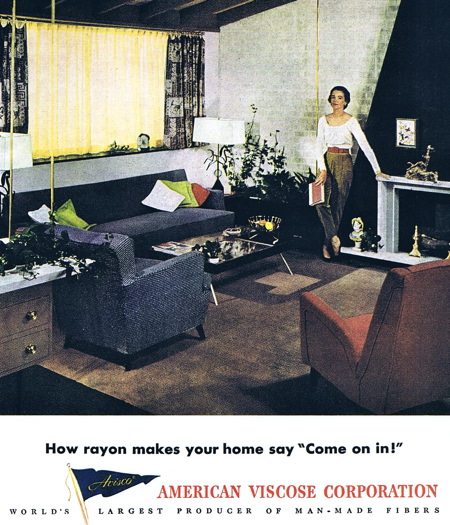
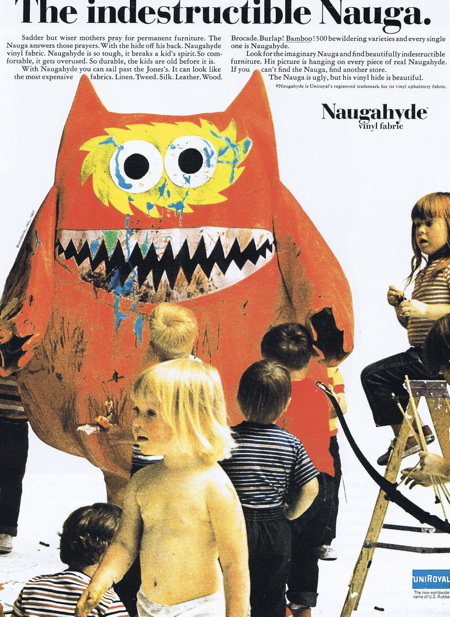
The plastic era not only gave us a host of new fake fabrics, it also provided a lot of extra-hard goods. My own family had a nice set of Melamine dinnerware, and I still have a few LustroWare kitchen items, though I can’t say I have anything made of Lumarith, a Celanese plastic material used, it seems, mostly in military goods.

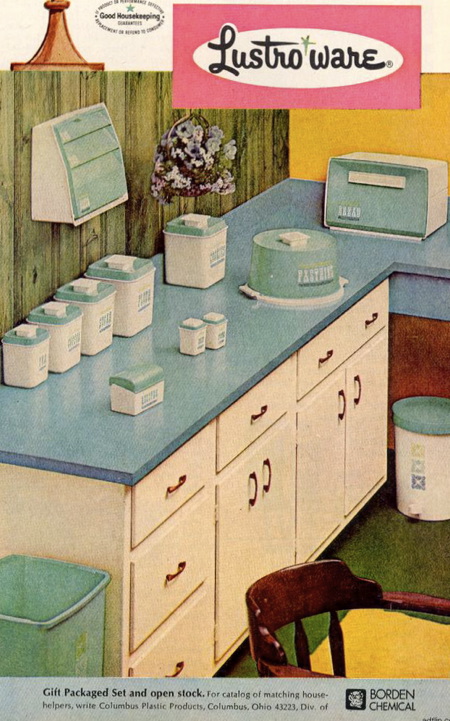

I know we have a lot to thank the big chemical and manufacturing companies for. I may be surrounded by Velon, Koroseal, and Lumarith and not even know it. But I think B.F. Goodrich may have gone a little too far in making their engineers drink rubber soup to make better jar rings — my old jar rings seemed just fine!



Oh, Gene, I will never forget plastic upholstery covers. I always thought that if people didn’t want you to sit on their sofas. They should just come right out and tell you. The smell of these was so atrocious, that when my parents covered the car seats with it, we kids just commenced throwing up even before my father turned over the ignition. I guess they figured out that covering everything in plastic was not such a good idea.
What a great new feature, Gene! It’s a lot of fun to see these ads.
most I knew, some I didn’t
Where on earth do you find all these great images? Loved this post on all the old brand names. And to think, the designers came up with these ads without Photoshop!
Great post, Gene. Some I remember, others not. But, thought about the advice regarding the future given to Dustin Hoffmann (trying to figure out his life) in The Graduate – “Plastics!” So, fun to see the beginning ads and applications.
Keep the fantastic additions going!
According to our friends at Wikipedia, Cellophane was named and patented in 1912, in France, by its inventor, Jacques E. Brandenberger. The name seems to have become a household word rather quickly. So much so that in 1934 Cole porter could pen,
“You’re the purple light of a Summer night in Spain,
You’re the National Gallery, you’re Garbo’s salary, you’re Cellophane.”
I love the design and communications paths Gene takes us down! I always wondered if “bakelite” was a company, a product or whatever.
Thanks Gene!
They should just come right out and tell you. The smell of these was so atrocious, that when my parents covered the car seats with it, we kids just commenced throwing up even before my father turned over the ignition. I guess they figured out that covering everything in plastic was not such a good idea.
sesli sohbet sesli chat